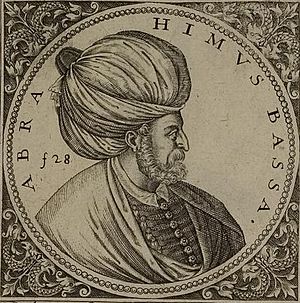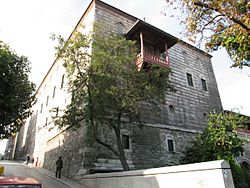Pargalı Ibrahim Pasha facts for kids
Quick facts for kids
Ibrahim
Pasha
|
|
|---|---|

Engraving of Ibrahim Pasha
|
|
| 28th Grand Vizier of the Ottoman Empire | |
| In office 27 June 1523 – 14 March 1536 |
|
| Monarch | Suleiman I |
| Preceded by | Piri Mehmed Pasha |
| Succeeded by | Ayas Mehmed Pasha |
| Ottoman Governor of Egypt | |
| In office 1525–1525 |
|
| Monarch | Suleiman I |
| Preceded by | Güzelce Kasım Pasha |
| Succeeded by | Güzelce Kasım Pasha |
| Personal details | |
| Born | c. 1495 Parga, Republic of Venice |
| Died | 15 March 1536 (aged 40–41) Constantinople, Ottoman Empire |
| Nationality | Ottoman |
| Spouse | Muhsine Hatun |
| Children | Mehmed Şah Bey |
Pargalı Ibrahim Pasha (born around 1495 – died March 15, 1536) was a very important person in the Ottoman Empire. He was the first Grand Vizier chosen by Sultan Suleiman the Magnificent. A Grand Vizier was like the Sultan's chief minister or prime minister.
Ibrahim was born a Christian. He became a slave when he was young. He and Sultan Suleiman became close friends during their youth. In 1523, Suleiman made Ibrahim his Grand Vizier. Ibrahim held this powerful job for 13 years. He gained a lot of power and influence. However, in 1536, Sultan Suleiman ordered his execution. Ibrahim's wealth was then taken by the state.
Contents
Who Was Ibrahim Pasha?
Early Life and Background
Ibrahim was born in Parga, a place that was part of the Republic of Venice at the time. His family was Orthodox Christian. We don't know his exact background, but he might have spoken a Slavic language, and also knew Greek and Albanian.
When he was young, between 1499 and 1502, he was captured during a raid. He became a slave of Iskender Pasha, an Ottoman governor. Ibrahim first met Prince Suleiman around 1514. This happened at Iskender Pasha's home near Edirne. Soon after, Ibrahim began working for Suleiman.
Rising to Power
Ibrahim Pasha became Grand Vizier in 1523. This was a very high position in the Ottoman Empire. He replaced Piri Mehmed Pasha. Ibrahim was also briefly the governor of Egypt in 1525. He helped to fix the way Egypt was run. He created a new set of rules called the Kanunname for Egypt.
In 1523, Ibrahim Pasha married Muhsine Hatun. She was the granddaughter of Iskender Pasha, who had captured him years before. This marriage helped Ibrahim, who was an outsider, to become part of the powerful Ottoman families. Historians used to think he married Sultan Suleiman's sister, Hatice Sultan. But new research shows his wife was indeed Muhsine Hatun.
Ibrahim Pasha's palace is still standing today. It is located on the west side of the Hippodrome in Istanbul. This palace is now the Turkish and Islamic Arts Museum.
Diplomatic Successes
Ibrahim was very good at dealing with other countries. He worked well with leaders from Western Europe. He often presented himself as the "real power" behind the Ottoman Empire. Venetian diplomats even called him "Ibrahim the Magnificent." This was a clever play on Sultan Suleiman's nickname.
In 1533, he convinced Charles V to make Hungary a state that paid tribute to the Ottomans. In 1535, he made an important agreement with Francis I of France. This deal gave France good trade rights in the Ottoman Empire. In return, they would work together against the Habsburgs. This agreement led to joint naval actions between France and the Ottomans.
Ibrahim Pasha had converted to Islam. But he still kept some connections to his family. He even brought his parents to live with him in the Ottoman capital. They also converted to Islam. His father took the name Yusuf and became a governor.
His Downfall
As Ibrahim's power and wealth grew, some people, including the Sultan's wife, Hurrem, became concerned. They felt he was becoming too powerful. After having dinner with the Sultan on March 5, 1536, Ibrahim Pasha was executed. After his death, Hurrem Sultan became a very important advisor to her husband, the Sultan.
Ibrahim Pasha in Pop Culture
- In the popular Turkish TV show Muhteşem Yüzyıl, the actor Okan Yalabık plays Pargalı Ibrahim Pasha.
- He is also a unique Ottoman governor in the video game Civilization 6. You can find him in the Gathering Storm expansion.
See also
 In Spanish: Pargalı İbrahim Paşa para niños
In Spanish: Pargalı İbrahim Paşa para niños
- Turkish and Islamic Arts Museum, which was once Ibrahim Pasha's palace
- List of Ottoman Grand Viziers
- List of Ottoman governors of Egypt
Images for kids



